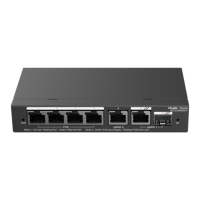CLI Reference Guide SNMP Configuration Commands
snmp-server host
Use this command to specify the SNMP host (NMS) to send the trap message in global configuration
mode. The no form of this command is used to remove the specified SNMP host.
snmp-server host {host-addr| ipv6 ipv6-addr} [vrf vrfname] [traps] [version {1 | 2c | 3 [auth | noauth
| priv]] community-string [udp-port port-num][notification-type]
no snmp-server host { host-addr | ipv6 ipv6-addr } [ vrf vrfname ] [ traps ] [ version { 1 | 2c | 3 { auth
| noauth | priv } ] community-string [ udp-port port-num ]
Set the name of vrf forwarding table
SNMP version: V1, V2C or V3
Security level of SNMPv3 users
Community string or username (SNMPv3 version)
The type of the SNMP trap message sent actively, such as
snmp.
By default, no SNMP host is specified.
If no type of the SNMP trap message is specified, all types of the SNMP trap message will be
included.
Global configuration mode.
This command must work with the snmp-server enable traps command in global configuration
mode to actively send the SNMP trap messages to NMS.
It is possible to configure multiple SNMP hosts to receive the SNMP Trap messages. One host can
use different combinations of the types of the SNMP trap message, but the last configuration for the
same host will overwrite the previous configurations. In other words, to send different SNMP trap
messages to the same host, different combination of SNMP trap messages have to be configured.
The example below specifies an SNMP host to receive the SNMP event trap:
Ruijie(config)# snmp-server host 192.168.12.219 public snmp
Enable to send the SNMP trap message.

